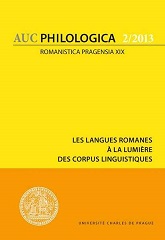La formazione di parole in un corpus diacronico: Appunti sulla produttività dei suffissi -mento e -zione nel Cinquecento
Word-formation in a Diachronic Corpus: Remarks on the Productivity of the Suffixes -mento and -zione in the Italian Language of the 16th Century
Author(s): Pavel ŠtichauerSubject(s): Language and Literature Studies
Published by: Univerzita Karlova v Praze, Nakladatelství Karolinum
Keywords: diachronic corpus; word-formation; morphological productivity; italian language of the 16th century; suffixes -mento and -zione
Summary/Abstract: This paper deals with two deverbal suffixes, -mento and -zione, in the Italian language of Cinquecento. The article aims to show, within the corpus-based quantitative approach to morphological productivity, that in the 16th century the suffix -zione cannot be considered a fully available means of word-formation but should be rather seen as a result of a massive borrowing process. The data, drawn from a 10 million corpus of Cinquecento (being part of the large LIZ 4.0 corpus), are presented along with the discussion of the type frequency, token frequency, vocabulary growth and the P values. The high token frequency of -zione is highlighted with special respect to the present-day situation where the suffix is the “frequency topscorer”. However, the main difference between the 16th century and the present-day -zione formations is stressed, i.e. the absence of nouns with -izzazione (and the scarce presence of -ificazione) which is due to the absence of causative verbs in -izzare and -ificare. It is only later, as witnessed by three major dictionaries, that these causative suffixes settle down as really available becoming thus the principal input to the suffix -zione.
Journal: Acta Universitatis Carolinae Philologica
- Issue Year: 2013
- Issue No: 2
- Page Range: 109-121
- Page Count: 13
- Language: Italian

